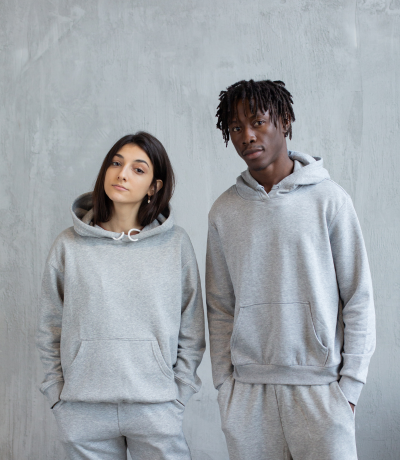6 Things You Should Never Wear on a Plane
19 August 2023
Let’s assume you have your boarding passes, your packed bag, and your carry-on all figured out. You’ve marked everything off ![]() your ‘night before you fly’ checklist. (Hint: don’t have one of those? Click that link for ours.)
your ‘night before you fly’ checklist. (Hint: don’t have one of those? Click that link for ours.)
What’s next?
What are you going to wear on the flight?
Most experienced flyers have a go-to flight outfit that considers comfort, temperature, and convenience―if that’s you, consider this a refresher course. If you struggle with what not to wear, consider this your comprehensive guide to inappropriate or problematic fashion choices when you fly.
Read on to find out what not to wear on a plane and what to wear instead.

1. Open-toed or high-heeled shoes
In summer, you may be tempted to get a head start on your vacation by wearing flip-flops or open-toe sandals, but this is a terrible decision. The same is true of high-heeled shoes.
Here’s why: you don’t know when the carpet in the plane or under the seats was deep cleaned last, and your exposed toes could be in contact with unseen fungi, germs, and worse. Plus, airplanes are cold! As for high heels, it’s super tricky to run in them no matter what Hollywood has sold you. You could have chafed heels and blisters if you have to run to a new gate. No bueno.
What to wear instead: compression socks and comfortable shoes. Sitting for long periods of time constricts the blood flow and makes your legs, ankles, and feet swell. Compression socks are designed to combat leg and foot soreness and prevent deep-vein thrombosis.
2. Tight clothing or shapewear
Don’t wear any clothing that’s tight or restrictive, including ill-fitting bras, tight pants, shapewear, and button-up shirts. Basically, anything that feels close to the body or tight when you’re on the ground.
Here’s why: the air pressure changes cause any gas inside your body to expand, so most people feel bloated when they fly. You will be very uncomfortable if you’re already wearing something that fits on the tighter side. As for button-up shirts, they can gap open and be more revealing than you’d like. Plus, depending on where you’re sitting, you may have to get up frequently.
What to wear instead: loose-fitting clothing that’s easy to move around in. Pants with some spandex are more forgiving and stretchy, so you’ll be comfortable in the air.
3. Floor-length clothing
Similar to open-toed shoes, avoid wearing anything that skims the floor, including pants, skirts, or dresses.
Here’s why: brutally honest flight attendants warn that the airplane bathroom floors are filthy.
We’re guessing you get the point—that’s not likely water you’re stepping in.
4. Rompers and jumpsuits
These one-piece clothing sets have made a big comeback, but you should not rely on these for plane attire. This is true of bodysuits and overalls too.
Here’s why: most one-pieces require total disrobing whenever you need to use the bathroom. That can be a much more complex maneuver to manage in a cramped airplane stall. Plus, anything you must take nearly off will likely drape onto the floor.
Did you know that airlines have shrunk the size of the bathrooms to fit more seats on each plane? Yep, many bathrooms are only 24 inches wide, making it a tiny space to move about in.
What to wear instead: Opt for loose-fitting two-piece sets that make it easy to access the toilet.
5. Anything revealing, obscene or offensive
There’s been a lot of discussion in some corners about whether a ![]() dress code for flying is a good idea. And yes, I acknowledge that what’s considered revealing, obscene, or offensive is a judgment call.
dress code for flying is a good idea. And yes, I acknowledge that what’s considered revealing, obscene, or offensive is a judgment call.
Here’s why: it’s about respect for other passengers―airplanes are filled with people of all ages and from all backgrounds. Lots of parents don’t want their children exposed to adult themes either. Plus, in some situations, passengers have been denied boarding due to the airline’s contract of carriage. American refused boarding to a ![]() fitness model in revealing clothes, and Southwest forced a passenger to
fitness model in revealing clothes, and Southwest forced a passenger to ![]() cover up.
cover up.
Pro tip: ultimately, you want to avoid offending if you can. See ![]() how to deal with unpleasant passengers for some tips should the occasion arise.
how to deal with unpleasant passengers for some tips should the occasion arise.
6. Strong smells, including body odor
If you’ve ever endured a long flight next to someone who reeks of body odor, cigarettes, or other offensive smells, you know how awful it can be. Nauseating even. The same is true for sitting next to someone wearing too much strong perfume.
Here’s why: it’s not only about maintaining your own personal health and being respectful to others. Most airlines’ carriage contracts indicate that “hygiene or odor” creating an unreasonable risk of offense or annoyance to other passengers isn’t allowed.
What to do in that situation: the flight crew can move you to another seat, deodorize the area, or request the passenger to leave as long as the odor isn’t caused by a physical ailment or condition (per the ADA). Either way, ![]() politely request help before the flight takes off.
politely request help before the flight takes off.
Pro tip: I always carry a tiny bottle of lavender oil. I primarily use a drop or two to help me relax on flights, but the scent is generally pleasing and can mask odors.
Related topics
Damian Tysdal is the founder of CoverTrip, and is a licensed agent for travel insurance (MA 1883287). He believes travel insurance should be easier to understand, and started the first travel insurance blog in 2006.
